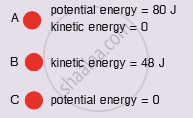Advertisements
Advertisements
Question
A ball of mass 0.20 kg is thrown vertically upwards with an initial velocity of 20 m s-1. Calculate the maximum potential energy it gains as it goes up.
Solution
Potential energy at the maximum height = initial kinetic energy
= `1/2` mv2
= `1/2×0.20 ×20 ×20`
= 40 J.
APPEARS IN
RELATED QUESTIONS
Show that the sum of kinetic energy and potential energy (i.e., total mechanical energy) is always conserved in the case of a freely falling body under gravity (with air resistance neglected) from a height h by finding it when
- The body is at the top.
- the body has fallen a distance x.
- the body has reached the ground.
Is energy a vector quantity?
State whether the object possess kinetic energy, potential energy, or both :
A bird running on the ground ____________.
What kind of energy is possessed by the following?
A compressed spring ____________.
A boy weighing 40 kg makes a high jump of 1.5 m.
What is his potential energy at the highest point? (g = 10 m/s2)
Name the device or machine which convert :
Chemical energy into electrical energy.
Name the device or machine which convert :
Electrical energy into heat energy.
A ball falls to the ground as shown below :
What is the kinetic energy of ball when it hits the ground?
In the case of negative work, the angle between the force and displacement is
A body of mass 10 kg falls from a height of 20 m to 8 m. Calculate:
- the loss in potential energy of the body, and
- the total energy possessed by the body at any instant? (Take g = 10 m s-2)
